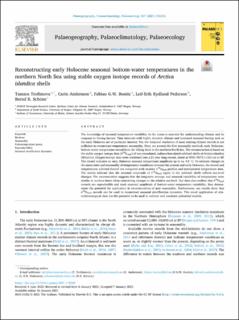Reconstructing early Holocene seasonal bottom-water temperatures in the northern North Sea using stable oxygen isotope records of Arctica islandica shells
Journal article, Peer reviewed
Published version

Åpne
Permanent lenke
https://hdl.handle.net/11250/2984339Utgivelsesdato
2021Metadata
Vis full innførselSamlinger
- Department of Earth Science [1034]
- Registrations from Cristin [9489]
Originalversjon
Palaeogeography, Palaeoclimatology, Palaeoecology. 2021, 567, 110242. 10.1016/j.palaeo.2021.110242Sammendrag
The knowledge of seasonal temperature variability in the ocean is essential for understanding climate and its response to forcing factors. Time intervals with highly dynamic climate and increased seasonal forcing such as the early Holocene are of particular interest. Yet, the temporal resolution of most existing climate records is not sufficient to reconstruct temperature seasonality. Here, we present the first seasonally resolved, early Holocene, bottom-water temperature record from the Viking Bank in the northern North Sea. The reconstruction is based on the stable oxygen isotope data (δ18Oshell) of two crossdated, radiocarbon-dated subfossil shells of Arctica islandica (Bivalvia). Oxygen isotope data were combined into a 21-year long record, dated at 9593–9573 (±55) cal yr BP The record indicates an early Holocene seasonal temperature amplitude up to ca. 4.5 °C. To estimate changes in the mean state and seasonality of temperature conditions between the present and early Holocene, the record and temperatures inferred thereof are compared with modern δ18Oshell profiles and instrumental temperature data. The results indicate that the seasonal amplitude of δ18Oshell signal in the subfossil shells reflects sea-level changes. The reconstruction suggests that the long-term average and seasonal variability of temperature were similar to modern times when considering changes in the relative sea level. Our data also confirm that δ18Oshell records are reproducible and track seasonal amplitude of bottom-water temperature variability, thus demonstrate the potential for application in reconstructions of past seasonality. Furthermore, our results show that δ18Oshell records can be used to reconstruct seasonal stratification dynamics. This novel application of sclerochronological data has the potential to be used to validate and constrain paleotidal models.
